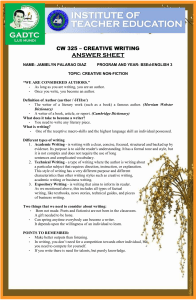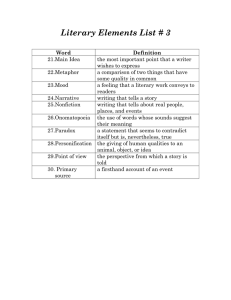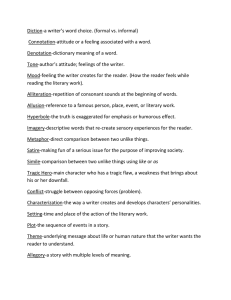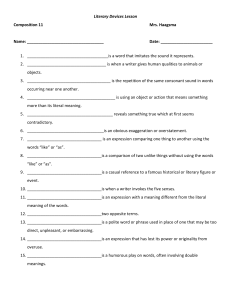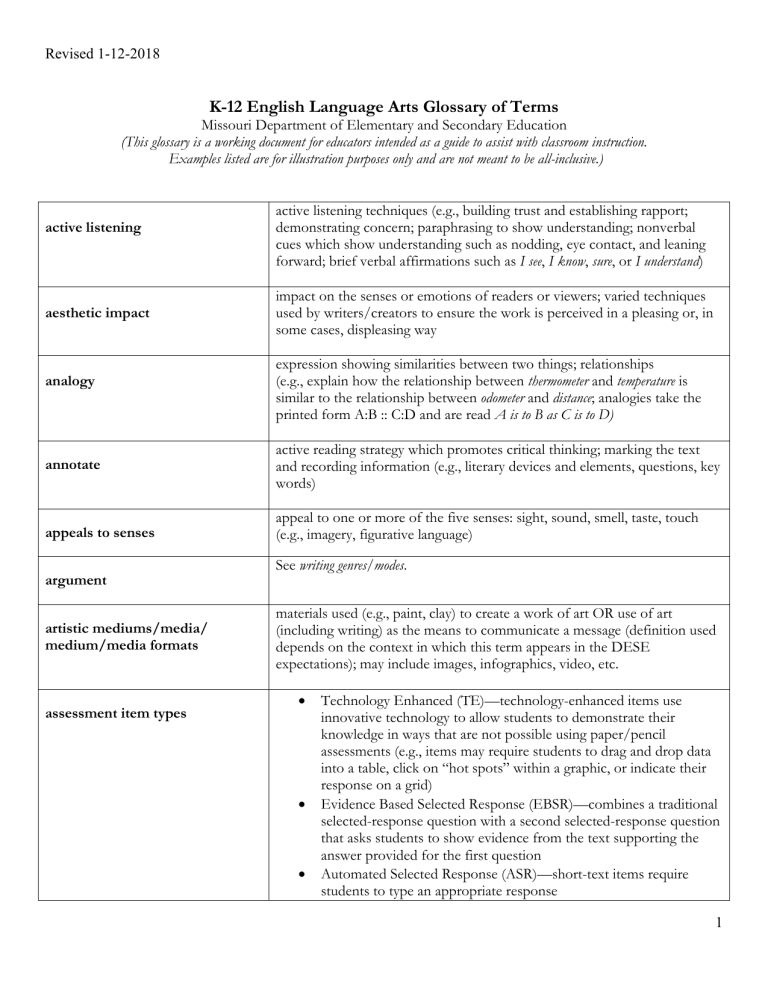
Revised 1-12-2018 K-12 English Language Arts Glossary of Terms Missouri Department of Elementary and Secondary Education (This glossary is a working document for educators intended as a guide to assist with classroom instruction. Examples listed are for illustration purposes only and are not meant to be all-inclusive.) active listening aesthetic impact analogy active listening techniques (e.g., building trust and establishing rapport; demonstrating concern; paraphrasing to show understanding; nonverbal cues which show understanding such as nodding, eye contact, and leaning forward; brief verbal affirmations such as I see, I know, sure, or I understand) impact on the senses or emotions of readers or viewers; varied techniques used by writers/creators to ensure the work is perceived in a pleasing or, in some cases, displeasing way expression showing similarities between two things; relationships (e.g., explain how the relationship between thermometer and temperature is similar to the relationship between odometer and distance; analogies take the printed form A:B :: C:D and are read A is to B as C is to D) annotate active reading strategy which promotes critical thinking; marking the text and recording information (e.g., literary devices and elements, questions, key words) appeals to senses appeal to one or more of the five senses: sight, sound, smell, taste, touch (e.g., imagery, figurative language) argument artistic mediums/media/ medium/media formats assessment item types See writing genres/modes. materials used (e.g., paint, clay) to create a work of art OR use of art (including writing) as the means to communicate a message (definition used depends on the context in which this term appears in the DESE expectations); may include images, infographics, video, etc. Technology Enhanced (TE)—technology-enhanced items use innovative technology to allow students to demonstrate their knowledge in ways that are not possible using paper/pencil assessments (e.g., items may require students to drag and drop data into a table, click on “hot spots” within a graphic, or indicate their response on a grid) Evidence Based Selected Response (EBSR)—combines a traditional selected-response question with a second selected-response question that asks students to show evidence from the text supporting the answer provided for the first question Automated Selected Response (ASR)—short-text items require students to type an appropriate response 1 Revised 1-12-2018 Multiple Choice (MC)—selected-response items (also known as multiple choice) present students with a question followed by multiple response options author’s purpose what an author wishes to accomplish in communicating with the audience (e.g., to entertain, persuade, inform) basic bibliographic information minimum amount of bibliographic information as specified by a citation system (e.g., MLA, APA) bias inclination to hold a particular view or perspective; revealed through the text structure, selected details, and word choices; subjectivity biographic blended writing cause and effect central message or lesson/moral lesson/theme relating to/telling a story about the life of a real person combination of techniques of two or more writing genres (e.g., narrative, expository, argumentative) within a single piece of writing; writing across genres the relationship between actions or events and outcomes or results main point or essence of the text; central message becomes theme in the upper grades character traits vs. personality traits not synonymous; personality is one of many possible character traits (e.g., personality, physical appearance, speech, behavior/actions, thoughts/feelings, interactions with other characters) characterization either direct (writer states character’s personality) or indirect (writer develops character’s personality through the character’s actions, words, thoughts, interactions with other characters) citation citing textual evidence/cite evidence claim/counter claim a reference which documents the source of a quote, fact, or idea (e.g., parenthetical citations are used internally in texts following the information, bibliographic citations are used at the end of texts in lists of works cited or consulted) to quote, paraphrase, summarize, and/or make brief reference to information from texts/source materials in support of thinking, ideas, or answers; when forming answers, students should provide attribution or make reference to the text/source from which the supporting evidence was found (does not refer to formal parenthetical documentation) an assertion of the truth, usually of a position typically considered as disputed or in doubt; counter-claim—a statement that negates or disagrees with the thesis/claim 2 Revised 1-12-2018 cohesive devices elements that bind writing together; include transitional words and phrases as well as repetition of key words and “reference words” that “point back” to ideas in the text compare/contrast to tell how things are alike (compare) and different (contrast); to examine both points of similarity and difference conflict a struggle between opposing forces in a story or play, usually resolved by the end of the work conventions rules or practices based on general consensus; apply to capitalization, punctuation, spelling, grammar, and usage (Refer to holistic writing scoring guides under conventions–severity, density, variety.) credibility accuracy, reliability, and trustworthiness of sources decode the process that a reader uses to recognize new words and meanings (e.g., phonics, word patterns, structural analysis, context clues) digital literacy ability to use digital technology, communication tools, and networks to locate, evaluate, use, create, and share information digital media any platform for or digital form of communication (e.g., wikis, blogs, digital videos, digital art, YouTube) digital sources information published and organized electronically and available over a network or database, typically through the Internet digital text text in digital format that can be accessed electronically; can be searched, rearranged, and/or read aloud by an electronic device diverse media varied ways for authors/creators to share ideas and messages with readers and/or viewers; media include written prose, poems, dramas, journals, live performances, films, videos, paintings, sculptures, posters, charts Diverse media in the Speaking and Listening strand refers to media that require listening. They contain an auditory component such as oral presentations, live discussions, performances, and video or auditory recordings. domain-specific words/vocabulary drafting vocabulary specific to a particular field of study a step in the writing process in which the writer takes the an idea during prewriting and begins to develop the text in the form the writer envisions; during the drafting process, the writer composes freely with a focus on developing the content of the writing 3 Revised 1-12-2018 drama composition in verse or prose that portrays characters and tells a story involving action and dialogue for the purpose of presentation on stage dramatic irony form of irony in which the reader or audience has a greater awareness of the situation than the characters in the work of literature/performance editing/proofreading elements of drama a step in the writing process in which the writer polishes the piece of writing, taking into account the needs of the reading audience; the writer edits for the conventions of spelling, grammar, punctuation, capitalization; the focus is on the final product features of a drama or play (e.g., cast, dialogue, scene, stage directions) elements of plot and setting features of plot and setting (e.g., plot—exposition, rising action, climax, falling action, resolution; setting—place, time, culture) environmental print words in the everyday environment; text, graphic and symbols that students see every day, inside and outside school (e.g., signs, billboards, menus, logos, labels) evaluate evidence explicit and implicit relationships to make a judgment of quality based on evidence facts, figures, details, quotations, or other sources of data and information that provide support for claims or analyses and that can be evaluated by others; should appear in a form and be derived from a source widely accepted as appropriate to a particular discipline, as in details or quotations from a text in the study of literature and experimental results in the study of science explicit is directly stated and spelled out; implicit is indirectly stated or implied fallacious reasoning faulty or flawed reasoning or logic (e.g., dogmatism, overgeneralization, faulty analogy, circular reasoning, bandwagon) fiction imaginative works of prose, primarily the novel and the short story; although fiction draws on actual events and real people, it springs mainly from the imagination of the writer figurative meaning/figurative language non-literal meaning of a word or phrase; used for comparison, emphasis, clarity, or freshness of thought (e.g., adage, euphemism, hyperbole, idiom, metaphor, oxymoron, paradox, personification, pun, simile, symbol) film techniques ways that meaning is created in film (e.g., camera shots, camera angles, camera movement, lighting, cinematography, frame composition) 4 Revised 1-12-2018 fluency knowledge of the syntactic, semantic, and graphophonic cueing systems coupled with knowledge of how language sounds (e.g., phrasing, in order to convey an oral interpretation of written text; more than accuracy and speed) formal style avoids colloquial and conversational elements of informal writing; used for academic and business writing forms of media means through which a message is conveyed; forms can be print (e.g., book, newspaper, billboard), broadcast (e.g., television), digital (e.g., web page, software) forms of poetry various structures of poems (e.g., sonnets, haiku, free verse, limericks) foundational works texts associated with the founding of a culture or society (e.g., well-known government documents, persuasive texts about the founding, epics about the origins of the culture) genre categories used to classify text (e.g., fiction, nonfiction, poetry, drama, informational, fable, folktale, graphic novel, literary nonfiction, memoir) graphic features pictures and other images that accompany a piece of text to enhance its meaning for the reader (e.g., photographs, drawing, maps, charts, diagrams, color, shading) high-frequency words common words that appear often in written or spoken language (e.g., the, of, and, a, to, in, is, you) historic time frame imagery inference vs. conclusion era/time period in which the plot is set; the cultural era reflected language that appeals to the five senses: touch, taste, smell, sound, and sight; mental pictures evoked through use of either literal or figurative language (see literary techniques/devices) inference - assumption based on available information conclusion - assumption developed as the next logical step for given information (e.g., A young boy is in a shoe store with an adult who is looking at the prices of boys’ shoes. The boy has holes in the toes of both shoes. One can infer that the boy has worn the shoes for a long time and has finally outgrown them. One can conclude the adult is going to buy new shoes for the boy.) inflectional endings a group of letters added to the end of a word to change its meaning (e.g., -s, -ed, -ing) informal style times at which a speaker or writer may incorporate a more relaxed tone and may, for effect, ignore some standard grammar and usage rules 5 Revised 1-12-2018 informational text informative/explanatory (writing) See writing genres/modes. See writing genres/modes. integrate information effectively combine and organize relevant information from multiple sources to develop a topic, answer a question, or prove a point interpretation explanation for the meaning of something; a stylistic representation of a creative work or dramatic role key elements/story elements of literary texts literary nonfiction/narrative nonfiction literary techniques/literary devices may include characters setting problem or conflict plot or text structure solution or resolution point of view theme (Not all literary works include all of these elements.) genre of writing that uses literary styles and techniques to create factually accurate narratives (e.g., biography, food writing, memoir, travel writing, some historical writing); brings real-life stories, such as personal experiences and historic events, to life using the techniques of fiction writing such as the incorporation of drama and depth of detail techniques used in writing which are intended to create a special effect or feeling (e.g., alliteration, euphemism, flashback, foreshadowing, hyperbole, idiom, imagery, irony, jargon, metaphor, onomatopoeia, oxymoron, paradox, personification, satire, simile, slang, symbolism) (As used in Missouri Learning Standards Expectations, the term literary device is used synonymously with the term literary techniques, those structures that enhance understanding and appreciation of the piece of writing.) main or central idea/topic main idea—what something is mostly about in informational or literary passages; purpose or gist of a passage; the primary message expressed by a passage; main idea of a paragraph may be explicitly stated in a topic sentence; "key concept" media literacy the ability to understand, analyze, and evaluate media (electronic or digital means and print or artistic visuals used to transmit messages) media venues channel or system of communication, information, or entertainment; varied ways for authors/creators to share ideas and messages with readers and/or viewers 6 Revised 1-12-2018 mood multimedia narrative writing/narrative techniques narrator literature—a feeling created in the reader which is evoked through the language of the text (e.g., reflective, melancholy) grammar— verb forms used to indicate the speaker’s attitude toward a fact or likelihood of an expressed condition or action (e.g., indicative, imperative, subjunctive) combined use of several media (e.g., Internet, video, audio, textual, graphic) See writing genres/modes. the person telling a story; narrative viewpoints include first person—narrator participating in the action tells the story second person—narrator speaks directly to the reader third-person omniscient—narrator knows the thoughts and feelings of all characters in the story third-person limited—adheres closely to one character’s perspective; more objective, relying primarily on what can be seen and heard to tell the story nonfiction writing that reflects real events; intended to explain, inform, entertain, persuade, or give directions (e.g., autobiography, biography, memoir, essay) non-literal language language that departs from everyday literal language for the sake of comparison, emphasis, clarity, or freshness of thought; figurative language nonverbal communications communication without words; body language (e.g., facial expression, gestures); sign language opinion a statement of personal belief, attitude, or preference; precursor to argumentation onset and rime organizational strategy/organizational structure/format parts of monosyllabic words in spoken language; smaller units than syllables but may be larger than phonemes onset: initial consonant sound of a syllable (the onset of bag is b-; the onset of swim is sw-) rime: part of a syllable that contains the vowel and all that follows it (the rime of bag is –ag; the rime of swim is –im. Rime is also referred to as a word chunk.) an approach to organizing the ideas and specifics in a text (e.g., definition, classification, compare/contrast, cause/effect, chronological, exposition) 7 Revised 1-12-2018 paraphrase persuasive writing/argument personality traits vs. character traits plot point of view/POV/ perspective/viewpoint using one’s own words to express the main ideas in what has been read, seen, or heard See writing genres/modes. not synonymous; personality is one of many possible character traits (personality, physical appearance, speech, behavior/actions, thoughts/feelings, interactions with other characters) literary term used to describe the events that make up a story or the main part of a story; events relate to each other in a pattern or a sequence; structure of a novel depends on the organization of events in the plot of the story perspective from which something is viewed; in literary text, narrator’s perception of what is happening in the story; in informational text, angle from which a speaker or writer presents information, the stance a writer takes on a topic (See narrator above for explanation of narrative points of view: first-, second-, and thirdperson.) (Note: Missouri testing precedent shows that the term point of view is used synonymously with the term perspective.) predict premise use of context and content clues to anticipate what might happen next an assertion which forms the basis for an argument, work, or theory prewriting strategies/planning a step in the writing process of gathering ideas; may be accomplished through sketching and/or jotting notes, utilizing a graphic organizer to organize thoughts, or getting impressions down in writing procedural texts a sequence of actions or steps needed to make or do something (e.g., recipes, science experiments, assembly manuals, instructions for playing games) production/publishing a step in the writing process in which the writer composes the text and presents it to the intended audience purpose the reason for which something is presented: to explain or inform, to entertain, to describe, or to argue recount retell in one’s own words 8 Revised 1-12-2018 reflection/reflective writing resolution retell revising to think about and write or speak one’s views in response to a text, presentation, or experience a conclusion that resolves the conflicts or issues presented in a text a comprehension strategy in which a student recounts story details more specifically than a summary part of writing and preparing quality presentations concerned with strengthening and reworking the content of a text relative to task, purpose, and audience (e.g., strong beginning, middle, and end; word choice; sentence structure; voice; deletion of unnecessary words, phrases, or sections) rhetoric the study and practice of effective expression; discourse (written or spoken communication) intended to move an audience to hold a particular viewpoint or take a particular action rhetorical devices literary, figurative, and syntactic devices used in text intended to influence the audience (e.g., allusion, analogy, understatement, parallelism, repetition) sensory language/details language that appeals to the five senses and evokes images of how something looks, sounds, feels, tastes, or smells sentence structures sentence types sentence variety four basic sentence structures include simple sentences: one independent clause and no dependent clauses, as in “The dog ate my homework.” compound sentence: two or more coordinate independent clauses, but no dependent clause, as in “George talked about global conflicts, and Harry listened to every word.” complex sentence: one independent clause and one or more dependent clauses, as in “I knew when you came in.” compound-complex sentence: compound sentence with two or more independent clauses and one or more dependent clauses, as in “Teachers speak and students listen when both are involved.” four basic types: declarative sentence - informs reader; punctuated with a period exclamatory sentence - expresses strong feelings; punctuated with an exclamation mark imperative sentence - commands, makes requests; usually punctuated with a period, sometimes with an exclamation point interrogative sentence - asks a question; punctuated with a question mark writing sentences other than with the basic subject-verb-object structure; making use of introductory phrases and clauses and/or varying sentence lengths to create more interest in the pacing and flow of the piece of writing 9 Revised 1-12-2018 sound elements standard citation system/standard format for citation may include alliteration—repetition of initial consonant sounds: Porky Pig ate a platter of pot roast. rhyme—repetition of final sounds in two or more words: wild, mild, child assonance—the repetition of vowel sounds within words: goat, bowl, scold consonance—the repetition of sounds within or at the end of words: cutler, antler, battler onomatopoeia—the use of words that sound like what they refer to: clop, bang, thud means for providing consistent, formal references to sources. (It is not necessary for students to memorize a specific style (e.g., MLA, APA); students should instead know how to use whichever style manual/guide is required for a particular research assignment.) story elements basic parts of a story: setting, characters, plot, conflict, point of view, and theme style speaker’s or writer’s particular use of language; manner of expression; a formal style uses standard formal English style manual systematic explanation of print conventions; rules for citing sources in text (e.g., MLA Guidebook, APA Publication Manual, Chicago Manual of Style) summary/summarize supporting details syntax synthesize technical meaning temporal words text features objective restatement of the essential ideas or major points in a text examples provided to describe, explain, or reinforce the main idea arrangement of phrases and clauses to convey meaning integrate a number of ideas, pieces of information, or data into a coherent whole literal or denotative meaning words referring to time (e.g., first, second, last, before) parts, other than the body of the text, that designate special features (e.g., front cover, back cover, title page, headings, tables of contents, glossaries, electronic menus, icons, captions, bold print, sub headings, indexes, key words, sidebars, hyperlinks) 10 Revised 1-12-2018 text structure/form framework, organization, or overall design of a work (e.g., compare/contrast, cause/effect, chronological, problem/solution) literary elements (e.g., characters, setting, problem/solution, plot) organized to allow the series of events to unfold; events may unfold in sequence or may be presented out of order via the use of flashbacks or visionary experiences nonfiction text may have one overall text structure or several different text structures (e.g., sequential, problem/solution, cause/effect, description, compare/contrast, classification) textual evidence theme transitional strategies/transitions validity visual media/visual elements of text visualize/visualization techniques/graphic visual experience vocabulary voice writing genres/modes specific support found in a text; see evidence the abstract concept explored in literary work; underlying or implicit meaning, concept, or message in a text; message may be about life, society, or human nature; often explores timeless and universal ideas and almost always implied rather than stated explicitly devices or words in a text that smoothly connect two topics or sections to each other; help readers understand how paragraphs work together, reference one another, and build to a larger point message that is relevant, accurate, justifiable, and logically correct graphic or visual text (e.g., illustrations, diagrams, maps, photographs, charts, graphs, timelines, animations, interactive elements on web pages, video) to help clarify ideas, allow the reader to follow the argument, share information, or provide data to picture the people, places, and/or actions that an author describes in text; a reading strategy to increase comprehension words one can understand and use correctly; developed by providing learners with life experiences that expand their knowledge of the world and the content they are exploring, providing opportunities for wide reading, and providing direct instruction of vocabulary critical to understanding content-area concepts distinctive tone or style of a particular writer; a reflection of the personality of the writer expository—imparts information, shares ideas and provides explanations and evidence informational/explanatory—falls under the umbrella of expository 11 Revised 1-12-2018 writing process writing; conveys information accurately (e.g., literary analyses, scientific and historical reports, summaries, memos, reports, applications, résumés, expository writing); increases reader’s knowledge of a subject, perhaps to help better understand a procedure or process; provides readers with enhanced comprehension of a concept opinion—takes a stand on a topic and supports opinions with facts, definitions and details persuasive—convinces audience to believe in an idea, sometimes leading to action argumentative—used for many purposes: to change the reader’s point of view; to bring about some action on the reader’s part; or to ask the reader to accept the writer’s explanation or evaluation of a concept, issue, or problem (includes counterclaims and rebuttals) narrative—conveys experience, either real or imaginary, and uses time as its deep structure; relates a story or a personal essay (e.g., anecdote, autobiography, memoir); can be used for many purposes, such as to inform, describe, instruct, persuade, or entertain literary nonfiction/narrative nonfiction—uses literary styles and techniques to create factually accurate narratives (e.g., biography, food writing, memoir, travel writing, some historical writing) non-linear, recursive steps used by writers in producing text, generally include prewriting, drafting, revising, proofreading/editing, publishing The Department of Elementary and Secondary Education does not discriminate on the basis of race, color, religion, gender, gender identity, sexual orientation, national origin, age, veteran status, mental or physical disability, or any other basis prohibited by statute in its programs and activities. Inquiries related to department programs and to the location of services, activities, and facilities that are accessible by persons with disabilities may be directed to the Jefferson State Office Building, Director of Civil Rights Compliance and MOA Coordinator (Title VI/Title VII/Title IX/504/ADA/ ADAAA/Age Act/GINA/USDA Title VI), 5th Floor, 205 Jefferson Street, P.O. Box 480, Jefferson City, MO 65102-0480; telephone number 573-526-4757 or TTY 800-735-2966; email civilrights@dese.mo.gov 12

